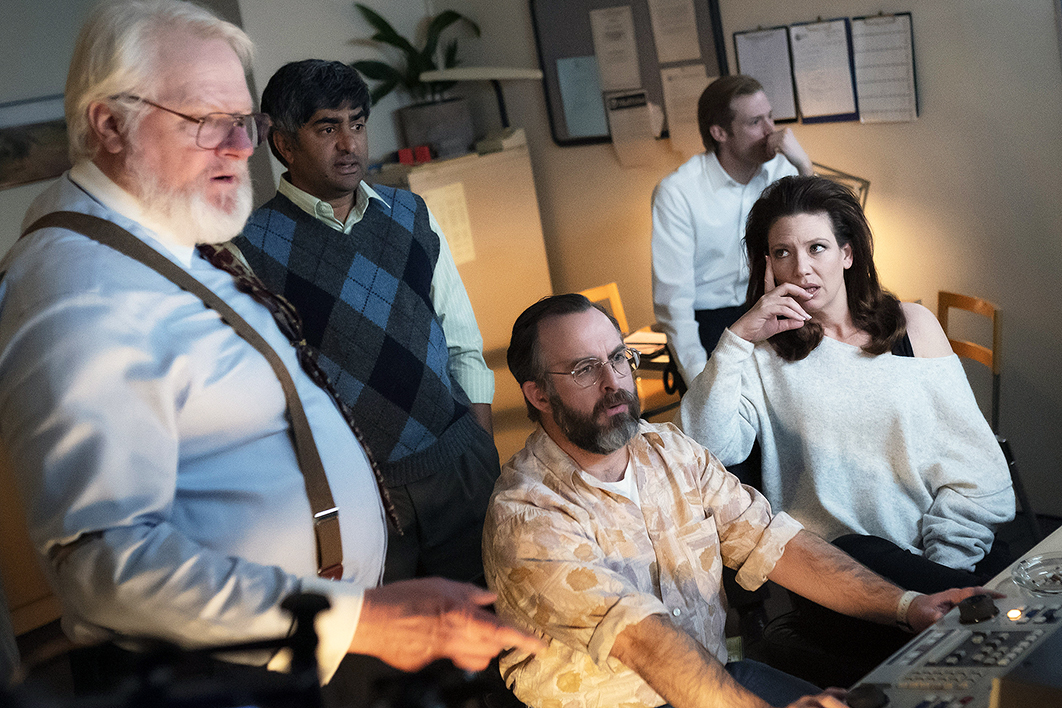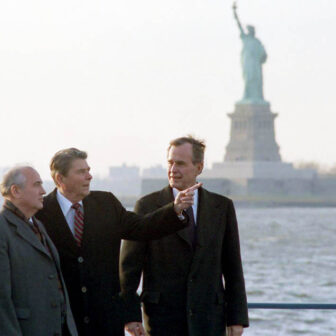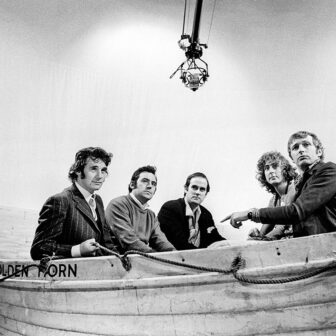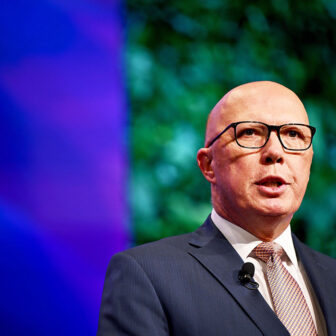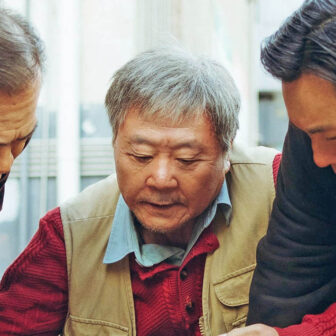Television newsreaders have not traditionally sparked much public curiosity. Some who rose to prominence in past generations may have been widely admired and respected, but the role was, quite literally, staid. Stuck behind the desk that served as a distancing device between themselves and the camera, they were a constant presence broadcasting information about a changing world.
Two high-rating television series devoted to the volatile lives of celebrity newsreaders show how the role has transformed. Morning Wars (Apple Plus) presents the contemporary newsroom as a chaotic epicentre through which producers, presenters, assistants, camera operators, technicians and guests make rapid transit as they attempt to head off a breaking story and give it their own spin.
ABC TV’s The Newsreader takes us back to the less frenetic media world of the 1980s, but acceleration is already a central theme, with presenters Helen Norville (Anna Torv) and Dale Jennings (Sam Reid) constantly running to front the camera as the latest rapidly unfolding story threatens to leave them in its wake.
It’s instructive to watch the two series in tandem. As a symbolic indicator of the growing stature of the presenter in the twenty-first century, the desk in Morning Wars has grown to absurd proportions, and the high voltage personalities who preside over it exercise dynamic influence. Promoted as celebrities in their own right, they become the brand that sells the news and know that their own survival is at stake in the cycle of evolving crises.
As the third season opens, the network, UBA, is the target of a takeover bid by maverick tycoon Paul Marks, whose love of high-speed vehicles — from cars to space rockets — evokes obvious associations. Played by Jon Hamm, he’s nicely matched with Billy Crudup as Cory Ellison, UBA’s own corporate Machiavel. Playing squash together, they plan a publicity stunt in which one of the star presenters, either Alex Levy (Jennifer Anniston) or Bradley Jackson (Reese Witherspoon), will take a trip in the space shuttle, live to air.
Each of these four principals has a different kind of leverage in the power play. What unites them is a determination to upstage any real-world news with their own storylines. It’s a risky enterprise for each of them, subject to sabotage by the others and by external players. When a hacker takes the network down mid-show and then threatens to release a cache of embarrassing communications, strategic realignments happen at lightning speed.
Some of these moves produce compelling items for the daily broadcast. The chair of the network’s board, Cybil Richards (Holland Taylor), is outed for a racist text and forced to do a mea culpa interview with the target of the slur, new presenter Chris Hunter (Nicole Beharie). In a ruthless encounter, both parties vie for new levels of frankness: Richards through candour and contrition, Hunter to force a reckoning for a whole suite of offences on the part of management.
The scene makes compelling viewing, not least for the culturally diverse staff gathered in the studio, whose reactions are shown in close-up. Perhaps they’re relishing it a bit too much, and there will be other kinds of repercussions. Until someone fronts the camera to give the wheel another spin, what happens next is anyone’s guess.
The Newsreader portrays a contrasting world in which television reporters are still chasing actual events rather than creating a hyperreality revolving around themselves. Compared to its US counterpart, the Australian series is a scaled-down production, reflecting the simpler enterprise of current affairs reporting at the time as well as the constrained budgets of today’s Australian producers.
The cast is smaller but strong, and director Emma Freeman makes the most of a talent pool that includes — as well as Torv and Reid in suitably charismatic lead roles — William McInnes as the irascible boss and Robert Taylor as the problematic eminence grise who has been forced to cede the anchor role to the next generation but is looking for payback. Michelle Lim Davidson suppresses her comic talent to play an earnest young producer crossing the cultural divide from a migrant family to the evolving multicultural environment of the television business.
Well-researched storylines draw on landmark events, including the July 1987 federal election, Melbourne’s Hoddle Street shooting a month later, the impending break-up of Charles and Diana, and the 1988 bicentenary. The ABC has released a weekly podcast hosted by Leigh Sales and Lisa Millar detailing the background to these events. Interviews with journalists involved are correlated with perspectives from members of the cast and production team.
In the second podcast, journalist Steve Carey, who was part of the original media response to the Hoddle Street massacre, recalls the experience as one of utter chaos, in which the reporter was just one more figure on the scene, as confused a witness as anyone else. On-screen, writer Kim Ho effectively grounds the episode in the detail of recollections such as Carey’s, while spinning a personal story for Norville, who makes a spontaneous decision about coverage of the fatalities just as the families are receiving the shock. The interwoven lines of tension make for a tightly constructed script.
For all its relatively modest production values, The Newsreader at its best gains dramatic traction of a kind that eludes Morning Wars, where the constant borderline hysteria palls and the ethos of hyperreality lacks genuine urgency.
So what is it that fascinates us about the news presenter as a public figure? Following their interview with Anna Torv, Sales and Millar recall Jana Wendt as a defining presence: the glamour, the command of the medium and the capacity to identify the running edge of a story.
But things have changed since Wendt’s prime years on 60 Minutes (1982–87) and hosting A Current Affair (1987–92). Judging from social media, the public are more frustrated than fascinated by those who tell the stories that make news. No doubt in an attempt to tackle this problem, Sales has compiled a collection of some thirty interviews with colleagues in television journalism, inviting them to reflect on the particular skills and qualities called for in their profession.
Storytellers features such distinguished contributors as Chris Reason, Marian Wilkinson, Robert Penfold, Stan Grant and Niki Savva beside younger talents who offer insights into newer problems and challenges facing reporters and presenters. Disability reporter Nas Campanella talks of the importance of voice quality in creating an empathic relationship with viewers. Bridget Brennan, who has become the ABC’s Indigenous affairs editor after a period as Europe correspondent, focuses on the selection and genesis of stories.
The interviews are brief, occasionally revealing, but not probing; together they seem too random an assemblage to offer any overarching perspectives. If there is a consistent theme that threads through the collection, it is the nervous challenge of holding the story together in a wide range of entirely unpredictable situations. As Lisa Millar says, “You never know what might happen.” •
